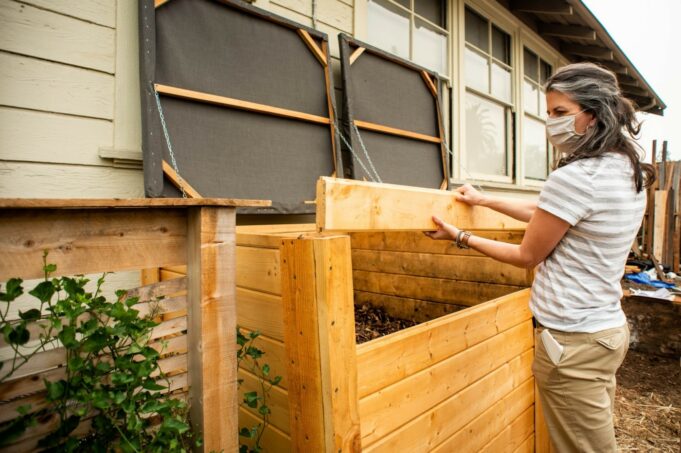Written by Brooke Staggs
It’s been six months since key parts of a new California law kicked in that requires all residents to start recycling food scraps. But it seems there are more questions and concerns about the process than ever, with confusion over what residents are supposed to recycle, and when and how and why.
So we researched and talked with experts to get answers to eight common questions about organic waste recycling in California.
Why are we talking about food scraps?
Organic waste, including food scraps and yard waste, releases large amounts of methane as it decomposes in landfills. Methane contributes significantly to climate change, since it traps even more heat in the atmosphere than carbon dioxide. So in 2016, Gov. Jerry Brown signed Senate Bill 1383 to mandate reductions in methane emissions in part by diverting 75% of organic waste from landfills by 2025.
Along with reducing methane, there are environmental benefits to the byproducts that can be made from recycled organic waste. Compost, for example, can turn dry dirt into rich, fertile soil. That offers immediate benefits, such as boosting growth in home gardens and reducing flood risks in areas hit with wildfire or drought, noted Monique Figueiredo, founder of Compostable LA. But compost also makes its own contribution to fighting climate change.
Since fertile soil that encourages plant growth pulls carbon out of the air and sequesters it down into the soil, in a process known as “drawdown,” experts say improving the quality of soil actually has the potential to actually reverse climate change. (Check out the Woody Harrelson-narrated documentary “Kiss the Ground” on Netflix for a primer on that process.)
Officials hope such perks create solid incentives around recycling organic waste. But for those who need more motivation, cities will be able to start fining residents who aren’t recycling organic waste in 2024.
So am I supposed to be recycling organic waste now?
Technically, yes. Under SB 1383, all California residents were supposed to stop putting food scraps and other organic waste in trash bins as of Jan. 1. However, per CalRecycle, 80% of cities, counties and other jurisdictions got extensions from the state that lets them delay collecting those materials for another year, while rural and mountain communities can wait until up to 2027. That’s why residents in some communities have gotten supplies and information on the process while many others have not.
When your community is ready to participate, you should get directions on what to do. In the meantime – or, for renters, in case that information was routed to a landlord or property manager – residents can call their city or waste hauler and ask where things stand.
So what exactly am I supposed to be collecting?
In general, you should be recycling most kitchen and yard waste instead of throwing it in your regular trash bin.
That means collecting leftover fruits and vegetables, meat and fish, bread, dairy products, coffee and filters, and food-soiled paper and cardboard. Don’t include plastic or foam food containers, utensils or bags.
Some communities have stricter limits on the types organic materials that can be recycled. So review information provided by your waste hauler or your city, or reach out to them for details.
Until the process becomes second nature, experts recommend printing out a cheat sheet showing what should be recycled and sticking it on the fridge or somewhere everyone in your house will commonly see it.
What do I do with food scraps I collect?
SB 1383 requires local governments to set up programs to collect organic waste and recycle it, just as they do with other recyclable materials. In many communities, that simply means adding food waste to the yard waste bins they already have, which will be picked up on regular trash collection days. But once again, check with your local city or waste hauler on where it should go and if you should start putting food scraps in their yard waste bins now, since policies and timing vary.
To make the process more convenient, many people opt to have a dedicated pail or other container inside their home that they use for daily food scraps, then dump into their yard waste bin as needed. Some cities or waste haulers are providing those pails as they roll out their organic waste recycling programs, but any solid container that fits your space will work.
Do I need to chop up food scraps?
Nope, that’s not required. But those materials will turn into compost much faster if they’re in smaller pieces, so Figueiredo recommends breaking larger scraps down a bit if you’re able.
Won’t the pail in my house or my yard waste bin start to stink or attract pests?
To keep odors, bugs and rodents at bay, be sure to regularly empty your kitchen pail and put your bin out for collection each week. Most foods won’t rot much in under a week.
For food scraps – particularly meat and dairy products – Figueiredo recommends keeping them in a sealed container in your fridge or freezer until it’s close to trash pickup day. That way they won’t have time to start smelling or attracting pests.
To keep your kitchen pail from getting messy, you can opt to buy compostable liners or just line it with used paper towels or newspaper. And for your outdoor bin, the more yard waste you layer in with the food waste, the less likely you are to get odors or pests.
Should I consider composting at home?
You don’t have to wait for someone else to pick up your food scraps to stop throwing them in the trash. That’s where personal or community composting can come into play. Those are the most environmentally friendly options, Figueiredo said, since major waste haulers often have to truck organic waste long distances to get it to large composting facilities.
For people who live in apartments or just aren’t inclined to try composting at home, many farmers’ markets or community gardens take organic waste that they can turn into compost.
If you’ve got some outdoor space, there are lots of free courses online or through local governments or organizations about how to compost at home. But the basic concept is to layer yard waste with food waste, then give nature time to work its magic.
For newbies, Figueiredo recommends getting a worm composter or an upright bin and doing cold composting, which typically requires very little attention and will turn food and yard waste into rich compost in a year or less. She also recommends skipping meat and dairy products to start, since those can make your compost pile more likely to smell or attract pests until you get the process down. But she said most problems can be fixed with simple tweaks, such as adding more yard waste or a bit of water to the mix.
Once the material looks like dark coffee grounds, with little to no scraps visible, it’s ready to be spread in your yard or donated to anyone who can use it.
But if I buy a pail and composting bin, which are typically made of plastic, am I just doing more harm than good?
While all plastics have been villainized in recent years, Figueiredo said it’s really single-use plastics that are the most damaging for the environment. She said buying a compost bin you plan to use for years, for a process that keeps waste out of landfills and improves the soil, isn’t the same as tossing out plastic water bottles each day.
There are compost bins made from recycled plastic, Figueiredo noted. She also recommends checking your local Facebook Marketplace, Craigslist ads or “buy nothing” groups, where you can usually pick up used composting supplies.
Lastly, she said not to overcomplicate the process. While she wouldn’t discourage anyone from doing whatever motivates them, she said people don’t need to spend lots of money and buy fancy gadgets to give composting a try.
Shared from OC Register











